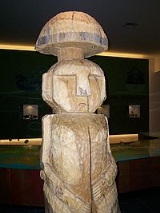
Chemamull
Encyclopedia
Chemamüll are Mapuche
statues made of wood used to signal the grave of a deceased person.
, a hard wood, or laurel
for their Chemamull.
The Mapuche made Chemamull in pre-Columbian times in a manner similar to headstones. According to testimony in books, Chemamull helped the deceased's soul reunite with its ancestors. This sculpture stood by the deceased during the funeral and was then erected next to over the grave.
Before the Spanish arrived, Chemamull may have been prevalent, but the Spanish considered the Statues idolatrous and many were burned.
Mapuche
The Mapuche are a group of indigenous inhabitants of south-central Chile and southwestern Argentina. They constitute a wide-ranging ethnicity composed of various groups who shared a common social, religious and economic structure, as well as a common linguistic heritage. Their influence extended...
statues made of wood used to signal the grave of a deceased person.
Description
The chemamüll are carved wooden statues, usually more than 2 meters tall, that represent the stylized body and head of a stylized human being. Statues may have male or female features. The Mapuche used whole logs of either Nothofagus obliquaNothofagus obliqua
Nothofagus obliqua, is a deciduous tree from Chile and Argentina. It grows from 33 to 43° South Latitude, in Chile and Argentina. The northern extent of this tree's range in Chile is considered to be the Vizcachas Mountains and La Campana National Park.-Description:N...
, a hard wood, or laurel
Laurel
-Botany:* Laurel family , a group of flowering plants** Azores laurel ** Bay Laurel , also called True Laurel** California Laurel ** Camphor Laurel...
for their Chemamull.
The Mapuche made Chemamull in pre-Columbian times in a manner similar to headstones. According to testimony in books, Chemamull helped the deceased's soul reunite with its ancestors. This sculpture stood by the deceased during the funeral and was then erected next to over the grave.
Before the Spanish arrived, Chemamull may have been prevalent, but the Spanish considered the Statues idolatrous and many were burned.

